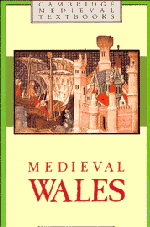Book contents
- Frontmatter
- Contents
- List of figures
- List of maps
- Preface
- 1 Wales in the dark ages
- 2 The Normans in Wales
- 3 The marcher lordships
- 4 The church in Wales
- 5 Crisis of identity: towards a principality of Wales
- 6 The Edwardian conquest
- 7 Under the heel: Wales in the fourteenth century
- 8 Resurgence and decline: the fifteenth century
- 9 A new dawn? The coming of the Tudors
- Select bibliography
- Index
- Cambridge Medieval Textbooks
5 - Crisis of identity: towards a principality of Wales
Published online by Cambridge University Press: 05 June 2012
- Frontmatter
- Contents
- List of figures
- List of maps
- Preface
- 1 Wales in the dark ages
- 2 The Normans in Wales
- 3 The marcher lordships
- 4 The church in Wales
- 5 Crisis of identity: towards a principality of Wales
- 6 The Edwardian conquest
- 7 Under the heel: Wales in the fourteenth century
- 8 Resurgence and decline: the fifteenth century
- 9 A new dawn? The coming of the Tudors
- Select bibliography
- Index
- Cambridge Medieval Textbooks
Summary
The close of the twelfth century marked a turning point in the history of Wales. Princely authority was gravely weakened in south Wales, and much attenuated in Powys. In the southern kingdom, the Lord Rhys had held in check the forces which might lead to disintegration, but his death in 1197 brought to an end the great days of his dynasty. Inspired by pleasure rather than politics, he had produced eight legitimate sons and seven bastards, and conflict over lands and power was the dominant theme of the story of Deheubarth in the early decades of the thirteenth century. The full effects of family rivalry were delayed for a few brief years. Gruffydd, eldest son of the Lord Rhys, succeeded his father and retained Dinefwr and the principal estates of the dynasty in Ystrad Tywi, and despite harassment by his rivals, he held his own until his death in 1201. From that point on, disputes produced a bewildering and constantly changing pattern of land tenure and power. Deheubarth, no longer a centre of effective power, became a kingdom of many memories. In Powys, the shift in power was more subtle. The death of Madog ap Maredudd in 1160 was followed by the division of his lands. His sons shared the land which formed northern Powys and which was later to be known as Powys Fadog: Gruffydd Maelor retained that part of Powys as a principality, and his brothers, Owain Fychan and Owain Brogyntyn, held the lesser territories of Mechain, Penllyn and Edeirion.
- Type
- Chapter
- Information
- Medieval Wales , pp. 90 - 110Publisher: Cambridge University PressPrint publication year: 1990
- 1
- Cited by



